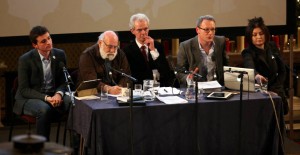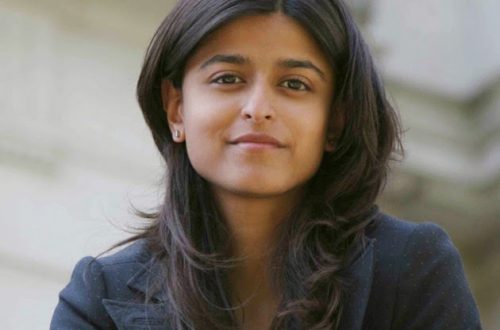Professor Alan Johnson
Editor of Fathom and Senior Research Fellow at the Britain Israel Communications and Research Centre (BICOM).

Note. St. James’s Church in London hosted the controversial Bethlehem Unwrapped Festival from 23 December 2013 to 5 January 2014. The centrepiece was an eight metre high replica of Israel’s security barrier built in the Church courtyard. On 4 January 2014 a panel event, ‘Both sides of the Barrier’, took place. The following is an edited version of the speech I gave that evening. A much shortened version was published at The Times of Israel.
Introduction
Thank you for the invitation. What a beautiful church this is.
A word about me. I speak as a friend of Israel, a friend of Palestine, and a friend of peace.
I have been a non-Jewish ‘two-state Zionist’ for 32 years now.
I edit a journal, Fathom. In the most recent issue we featured two voices raised in support of the ‘two states for two peoples’ solution. That’s what I left academia to work for three years ago – I was a professor of politics for 20 years. One voice was a Palestinian, a friend of mine, Hitham Kayali, a man I have shared platforms with, and the other was Toby Greene an Israeli, a friend with whom I have written articles on the ‘two states for two peoples’ solution. That’s me.
A word about you.
I praise the organisers of Bethlehem Unwrapped for talking on their website about seeing the point of view of both sides, recognising that for Israel the barrier was built to prevent terrorism, and for recognising explicitly the right of Israel to exist with secure internationally recognised borders.
Those are sound principles.
But the event itself, the entire way it has been framed, and the pretend barrier especially, has, in the view of many, failed to live up to those principles.
The Israeli embassy felt unable to participate.
A lot of people who come from my side of this debate don’t think I should be here, either. They think I am giving legitimacy to what they see as a thinly veiled one sided anti-Israel propaganda festival camouflaged as a ‘human rights’ and ‘culture’ promotion.
The Spectator magazine has accused this Church of ‘moral squalor’.
What’s gone wrong here? How can we put it right?
I want to talk about three security barriers tonight.
First, the pretend barrier outside the Church here in London.
Second, the real barrier in Israel and the West Bank.
Third, what I will call the intellectual separation barrier, on one side of which is a ludicrously simplistic, and frankly counter-productive, ‘activism’ on the Israeli-Palestinian conflict, and on the other side of which is, well, the actual Israeli-Palestinian conflict in all of its historical depth and political complexity, with its painstaking search to reconcile competing narratives, that is inching towards mutual recognition, and to the excruciating compromises that will make a final status agreement possible.
I want to say that we need to tear down that intellectual separation barrier.
Why?
Because the constructive pro-Israeli, pro-Palestinian, pro-peace approach we need has three characteristics:
First, it is open to the full force of the sheer bloody complexity of the conflict, and is willing to wrestle with that complexity, not evade it.
Second, it is fully aware of the determining contexts of the conflict, among which is security.
Third, it refuses to demonise either side, working with both parties, seeking co-existence, compromise, mutual recognition and peace.
The pretend barrier outside the church – however well intentioned – does the opposite:
1. it is reductive, ignoring the political complexities of the conflict.
2. it is decontextualised, marginalizing at best, discounting at worst, the security case for the barrier.
And because it is reductive and decontextualising, it is also, ultimately,
3. demonising – framing the barrier as a pure violation of human rights by cruel Israelis, a motiveless imprisonment of underlings by overlords, quite possibly by racists of an apartheid type.
Part 1: The pretend barrier
Let me dramatise the gulf there is between your pretend barrier and the real barrier. That gulf tells us much about the intellectual separation barrier.
Two things happened just before Christmas.
The first thing happened on December 22. A bomb exploded on a bus from Tel Aviv to Bat Yam. Luckily, a passenger David Papo examined the suspicious bag before disembarking. ‘I opened it and saw a red wire coming out of it and I immediately understood what it was.’ (Israelis do.)
And where did the perpetrators come from? Bethlehem.
And how did they cross into Israel with their 2 kilogram bomb, with its nails and bolts? According to Haaretz – the left-wing anti-Government, Peace Now supporting Israeli newspaper Haaretz – the bomber ‘snuck into Israel … through a breach in the security fence.’
The second thing happened the day after, on December 23rd, just outside in the church courtyard, here in the parallel universe of activist London, at the public launch of the pretend barrier. One of my fellow panelists, Jeff Halper, said this about the real barrier – I take this from the You Tube video – ‘This is not a wall built for security … It doesn’t protect Israelis in any way.’
He was cheered for saying that. Cheered.
Let’s drill down a bit.
The pretend barrier is reductive.
It reduces a complex situation to simplicities; a complex national conflict between two peoples, between right and right, requiring careful mediation, into a simple human rights struggle between right and wrong, requiring from us only our moral outrage.
For example, you say walls are bad and bridges are good.
You think Israelis think the barrier is good?
Well, they don’t. They think it is necessary.
Ten years ago, the current Israeli Ambassador Daniel Taub was legal director at the Israeli Ministry of Foreign Affairs. This is what he said about the barrier in 2004.
We did not want to build this fence. It’s ugly, it’s expensive. Even though it’s temporary, it causes genuine hardship to many Palestinians which we must take every measure to ease. That’s why we did not build it for over two and half years of Palestinian violence, why we waited while 935 Israelis were killed. Until we could wait no longer. Until March 2002, a month in which 37 terrorist attacks in 31 days murdered 137 people, including the Passover night massacre. We could wait no longer because the fence works. The simple truth is that the fence is saving lives.
The pretend wall is radically decontextualised.
In other words, it stands there, such an impressive sight, but in isolation from the rationale for its creation – the scourge of terrorism and the search for security.
I’m sorry, but it does. Isolated, back-covering, throat-clearing, half sentences about security, disconnected from the entire thrust of the festival’s speakers, topics and the exhibit itself, is not good enough. Especially when even those half sentences hint that it’s only a ‘claim’ of the ‘Israelis’ that the barrier is there to meet security needs. A mere ‘government position’. And when you have cleared your throat in that way, and then mount over a week of activities that takes one side – tear this wall down! – you don’t then get to say to the media ‘we are not taking sides’. There really is a good deal of having your cake and eating it going on.
Let’s bring context back in.
Part 2: The real barrier
Why was the barrier built? It was built to stop suicide bombers who were killing Israelis.
Before we get into statistics and tables let’s remember just one of those Israelis.
Simona Rodin does not feature in your pretend wall. Not one of the victims do. Well, by God she is going to tonight.
She was 17 when she died, on June 1, 2001. She went to the Dolphinarium discotheque in Tel Aviv. So did Said Khutari, who travelled from the West Bank town of Kalkilia; walked right over, with the intent of causing mass destruction. Strapped to his chest was a deadly mix of powerful explosives and hundreds of steel ball bearings. In the Disco, at 11:26 p.m. he blew himself up, murdering Simona and 20 other youngsters, and injuring 132.
Simona was not a ‘government position’. Nor, that night, were Roman, or Yevgenia or Ilya or Anya or Katherine or Aleksei or Mariana or Irena or Yelena or Yulia or Raisa – who was just 15 – or Dani, Simona, Ori, Liana or Yael.
When it comes to the second intifada that made the barrier essential, I could read names out to you all night long.
Look, the facts about the origin and rationale for the barrier are very clear.
Here they are.
At the Camp David negotiations in 2000, Ehud Barak the Israeli PM offered a Palestinian state in over 90 per cent of the West Bank. Palestinian leader Yasser Arafat said no, walked away without making a counter offer, and launched the Second Intifada – a wave of Palestinian suicide bombings and other terrorist attacks on Israel.
By 2002, a fatal suicide bombing was carried out in Israel nearly every two weeks on average.
In just three years, over 900 Israeli civilians were killed and 6000 injured by terrorism coming from West Bank. (More than a dozen fatal terrorist attacks came from Bethlehem area, by the way.)
In just one month, March 2002, Palestinian terrorists killed 80 Israelis and wounded 600 in twelve different suicide attacks.
In short, the barrier is a legitimate, emergency, temporary, defensive response to terrorism on an unprecedented scale.
And you know what? The barrier works.
Here is a challenge to you. Next time the pretend wall is exhibited – and I fear it will now tour the world, dragging the intellectual separation barrier in its wake – I dare you to project this table onto it.
While there are other factors that also help to explain the steep decline in terror attacks that took place after 2002, the security barrier played a major role.
Fact. Where the barrier was erected, there was a 30 per cent drop in the number of terrorist attacks that took place in 2003 compared to 2002; and a 50 per cent decrease in the number of victims murdered by terrorists in 2003 compared to the previous year.
Fact. Where construction of the barrier had not begun, in the southern part (Judea) of the West Bank, there was no decrease in the number of terrorist attacks between 2002 and 2003.
Fact. Overall picture: a decrease of slightly more than 90 per cent in the number of attacks: from an average of 26 attacks a year before the fence, to three attacks after. This means a decrease of more than 70 per cent in the number of Israelis murdered: from an average of 103 slain per year before the fence to 28 after erection of the fence. Similarly, this means a drop of more than 85 per cent in the number of wounded: from an average of 688 a year before the fence to 83 wounded per year after it was built.
That’s not a ‘the government position’. Those are real lives, saved.
And those lives must be allowed to enter into your moral calculus.
Three ‘by the ways’.
By the way, all but about five per cent of the barrier is an electronically monitored fence. The wall is in built up areas where there is not enough room for a monitored fence, or where there is a need to protect against sniper fire.
By the way, Bethlehem is not ‘surrounded’ by the barrier, as the website says. It is separated from Jerusalem by the barrier – with a checkpoint. After the terrorist attack of December 22, maybe you can at least see a dilemma?
By the way, the reason the barrier does not follow the 67 lines is that it’s a security barrier, not a political barrier. The aim of the fence is simply to save lives, so the route of the security barrier is determined by the need to prevent Palestinian terrorists from reaching towns and cities they target. A fence along the Green Line would be a political not a security line, running through villages and valleys with high ground on either side, and so it would not achieve that aim. Which is why the fence diverts at points on both sides of the Green Line.
Some of you may be thinking, well, the Israelis would say the barrier works wouldn’t they?
OK, so what do the Palestinian terrorists say. They should know.
Palestinian Islamic Jihad] leader Ramadan Abdallah Shalah said ‘[The Israelis] built a separation fence in the West Bank. We do not deny that it limits the ability of the resistance [i.e., the terrorist organizations] to arrive deep within [Israeli territory] to carry out suicide bombing attacks …’ (March 23, 2008).’
Why not project that admission onto your pretend barrier?
Shalah told Hezbollah’s Al-Manar TV, ‘There is the separation fence which is an obstacle to the resistance [i.e., the terrorist organizations], if it were not there, the situation would be entirely different’ (November 11, 2006).’
He means ‘we could be slaughtering more Israelis of it wasn’t for the barrier.’
Mousa Abu Marzouq the deputy chairman of Hamas’s political bureau in Damascus, was asked why the suicide bombing activity had decreased. He said that ‘[carrying out] such attacks is made difficult by the security fence.’ (Ikhwan Online, the Muslim Brotherhood Website, June 2, 2007).
That’s the Hamas whose Charter begins ‘Israel will exist and will continue to exist until Islam will obliterate it, just as it obliterated others before it.’ And that’s theo-fascistic.
If I was to write on your pretend wall, I’d take my cue from the great US radical, folk singer, and Dylan precursor, Woody Guthrie. He had a big sticker on his guitar: ‘this machine kills fascists.’ I’d amend that and stick it on your wall – ‘this barrier stops fascists’.
Part 3: The intellectual separation barrier
The pretend barrier demonises because it is reductive, because it is decontextualised.
Demonising Israel and Israelis by being reductive and decontextualising about the conflict – that is how the intellectual separation barrier works. That’s how it cuts off so many well-meaning European folk from playing a constructive role in promoting peace.
You yearn for simplicities. But there are no simplicities to be had. Please listen to the great Israeli novelist and Peace Now founder Amos Oz. He writes this in his wonderful little book How to Cure a Fanatic:
Who are the Good Guys? That’s what every well-meaning European … always wants to know, first and foremost. Who are the good guys in the film and who are the bad guys? In this respect Vietnam was easy … the same with Apartheid, [but] when it comes to the foundations of the Israeli-Arab conflict, in particular the Israeli-Palestinian conflict, things are not so straightforward. The Israeli-Palestinian conflict is not a Wild West movie. It is not a struggle between good and evil, rather it is a tragedy in the ancient and most precise sense of the word: a clash between right and right … What we need is a painful compromise. The word compromise has a terrible reputation in Europe, especially among young idealists … Not in my vocabulary. For me the word compromise means life. And the opposite of compromise is not idealism, not devotion: the opposite of compromise is fanaticism and death.
So your style of ‘activism’ does not advance the quest for peace but rather turns global civil society into a force that hampers the quest for peace. How so? By turning it into a force that seeks to pull Israel down, not build Palestine up. By destroying the trust Israelis need to have trust that the international community – of which global civil society is now an increasingly vital part – ‘gets’ Israel’s unique security needs, so that Israel can then take risks for peace.
For example, the organizer of this event, Justin Butcher, said this in an interview with Lebanon’s Daily Star about the real barrier: ‘It should be dismantled. We’re simply calling for that to happen, which in my view is relatively uncontroversial. This is a Christian church standing up in solidarity with the rights of an oppressed people.’
Reading that – well meaning but utterly naïve, breezily simplistic in the extreme, and, I am sorry, but not a little callous; refusing to acknowledge why the barrier went up or what would happen if it was just ‘dismantled’ – I was reminded of a rather wonderful woman who went to the real wall and the conversation she had there.
The brave feminist and Muslim writer Irshad Manji travelled to the barrier at Abu Dis and she wrote this.
‘When I went to see its towering cement slabs in the West Bank town of Abu Dis last year, an Arab man approached me to unload his sadness. ‘It’s no good,’ he said. ‘It’s hard.’
‘Why do you think they built it?’ I asked.
The man shook his head and repeated, ‘It’s hard.’ After some silence, he added, ‘We are not two people. We are one.’
‘How do you explain that to suicide bombers?’ I wondered aloud.
The man smiled. ‘No understand,’ he replied. ‘No English. Thank you. Goodbye.’
I think the reason Bethlehem Unwrapped has been criticized is not that people, in bad faith, seek to demonise you. It’s really quite wrong to suggest that. Rather, I think it’s because they think the event shares much with that response of the man in Abu Dis. When many people see what you have created here they say, ‘Please, Israel tried to negotiate peace and the reply was to murder us in our homes, synagogues, supermarkets, discos and pizza parlous, day after day. That’s why we built the barrier.’ Whatever you intended, the pretend wall seems to reply: ‘No understand, thank you, goodbye.’
Irshad Manji concludes with words that I think might usefully prompt reflection among the church leaders. ‘People, especially those privileged with a good education,’ she wrote, ‘cannot walk away from these questions as my interlocutor in Abu Dis did. If we follow in his footsteps, we are only conspiring against ourselves.’
I don’t think the pretend barrier is an example of the church involving itself in ‘moral squalor’ as the Spectator said this week. But I do think it is, literally, a monument to walking away from the tough questions.
Thank you for listening.


